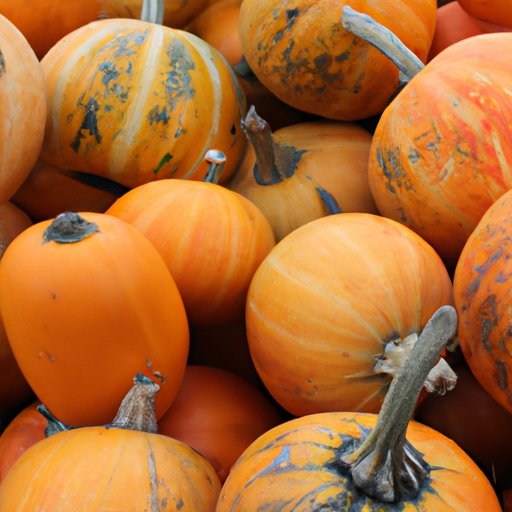Introduction
As autumn approaches, pumpkin patches and gardens begin to flourish with its bright orange produce. To ensure the quality of the pumpkin, it is crucial to know when to pick them. Harvesting pumpkins too early can lead to spoilage, while picking them too late may cause over-ripening. In this article, we will cover the five essential signs of a ripe pumpkin, a guide for harvesting, and the importance of knowing a pumpkin’s life cycle to determine when to pick.
The 5 Signs That Your Pumpkins Are Ready to Be Picked
Pumpkins generally mature late in the season, averaging around 85-120 days for most varieties. Knowing the signs of a ripe pumpkin is key to determining the best harvest time.
Full Maturity and Hardness of the Pumpkin’s Skin
A ripe pumpkin will have a hard outer shell that cannot be scratched or punctured easily. Test this by pressing a fingernail onto the skin’s surface. If it leaves a dent, the pumpkin is not ready for harvest.
Deep Orange Color or Fully Developed Hues
A fully matured pumpkin will have a bright orange color or fully developed hues that reflect the plant’s natural pigmentation. Be aware of green patches on the pumpkin skin, as it may indicate unripe fruit.
Cracks or Lines Appearing on the Pumpkin’s Surface
Another sign of a mature pumpkin is its surface cracks or lines that appear as the fruit continues to mature. These cracks are fine and almost barely visible, indicating full ripeness.
Drying of Pumpkin Stems or Brown Color
The stem, or “handle,” connecting the fruit to the vine must dry out before picking. When the stem’s color is brown and tough to the touch, it signifies a ripe fruit ready to be picked.
Dying Back of the Plant Leaves and Vines
The pumpkin plant’s vines and leaves around the fruit will begin to die back once the pumpkin reaches maturity. This process helps divert nutrients to the fruit, promoting its ripening.
A Guide to Harvesting Your Pumpkins: How to Know When They’re Ripe
Harvesting pumpkins is a straightforward process, but knowing when to pick them can be tricky. Below is a guide for checking each sign.
- Inspect the pumpkin’s skin by pressing your nail into its surface. If it leaves a dent, the pumpkin is not ready for harvest.
- Check the pumpkin’s color, looking for a deep orange or fully developed hues.
- Look for surface cracks or lines almost invisible to the eye.
- Check the stem’s color and texture, making sure it is dry, tough, and brown in color.
- Examine the pumpkin plant’s vines and leaves close to the fruit for signs of withering and dying back, indicating the pumpkin is mature.
When harvesting pumpkins, safety is crucial. Use gloves to protect your hands and a sharp cutting tool, like a pruning shear, to avoid damaging the fruit or accidentally slicing yourself.
Don’t Pick Too Early! How to Tell When Your Pumpkins Are Fully Mature
Although tempting to pick early, it’s best to wait until the pumpkin is fully matured for the best quality and longevity. Picking pumpkins too early may lead to stunted growth, change of color, poor flavor, rot, and disease. A fully matured pumpkin will develop natural resistance to external factors, making it less susceptible to rot, disease, and pests.
The Ultimate Checklist for Picking Perfectly Ripe Pumpkins
To ensure you pick the best possible pumpkins, follow this ultimate checklist:
- Check for full maturity and hardness of the pumpkin’s skin.
- Look for deep orange color or fully developed hues.
- Note cracks or lines appearing on the pumpkin’s surface.
- Ensure drying of pumpkin stem or brown color.
- Check for dying back of the plant leaves and vines around the pumpkin.
- Use gloves and a sharp cutting tool to harvest safely.
From Green to Orange: Understanding the Life Cycle of a Pumpkin and When to Harvest It
To know when to harvest pumpkins, it’s essential to understand its life cycle. Pumpkins grow in four stages:
- Vegetative Growth: The pumpkin plant sprouts, generating leaves and plant structure to photosynthesize and absorb nutrients.
- Flower and Pollination: As the plant expands, flowers will bloom and pollinate with designated male and female flowers. Fertilized female blossoms will begin to grow pumpkins.
- Fruit Growth: The pumpkin will continue to grow, absorbing nutrients and drawing energy from the plant. During this stage, the fruit begins to take shape and develop its exterior.
- Maturity: As the pumpkin fills out, it will begin to show signs of maturity, such as color changes and tough stem. Once matured, the fruit will separate from the vine manually or naturally fall off.
Using this knowledge of the pumpkin’s life cycle, you can determine whether a pumpkin is mature and ready for harvest by following the guidelines we’ve provided.
Conclusion
Picking pumpkins at the right time is crucial for optimal quality and longevity, making it essential to know the signs of ripe and mature pumpkin. To recap, the five signs of a mature pumpkin are; full maturity and hardness, deep orange color, surface cracks, drying stem, and dying back of the plant leaves and vines. Use the ultimate checklist to ensure perfectly ripe and safe harvesting with gloves and sharp cutting tools. Remember to wait until the pumpkin is fully matured for best results, and use its life cycle to determine its ideal harvest time. With these tips, you’re well on your way to picking the perfect pumpkins for autumn.
(Note: Is this article not meeting your expectations? Do you have knowledge or insights to share? Unlock new opportunities and expand your reach by joining our authors team. Click Registration to join us and share your expertise with our readers.)
